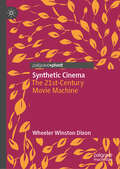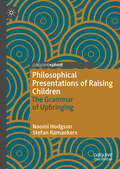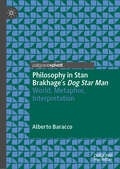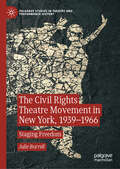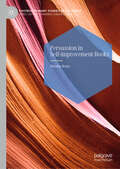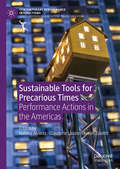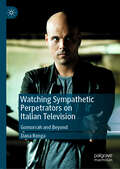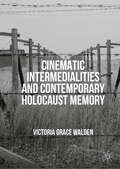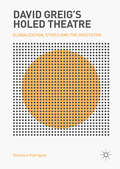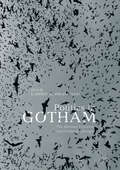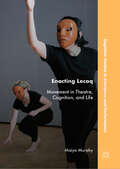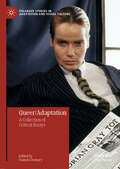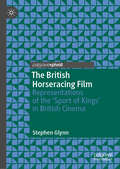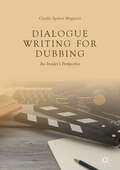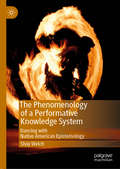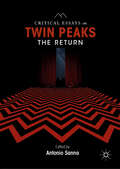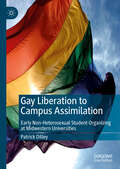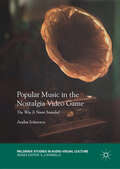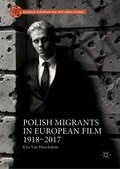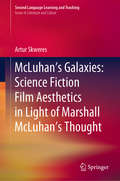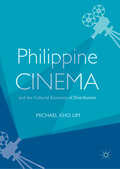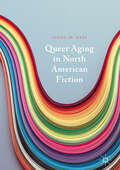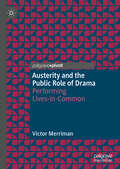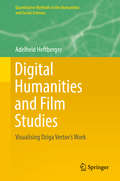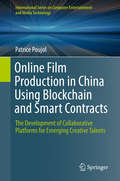- Table View
- List View
Synthetic Cinema: The 21st-Century Movie Machine
by Wheeler Winston DixonIn this book, Wheeler Winston Dixon argues that 21st-century mainstream filmmaking is increasingly and troublingly dominated by "synthetic cinema." He details how movies over the last two decades have fundamentally abandoned traditional filmmaking values through the overwhelming use of computer generated imagery, digital touch ups for the actors, and extensive use of green screen technology that replace sets and location shooting. Combined with the shift to digital cinematography, as well as the rise of comic book and franchise cinema, the temptation to augment movies with lavish, computer generated spectacle has proven irresistible to both directors and audiences, to the point that, Dixon argues, 21st-century commercial cinema is so far removed from the real world that it has created a new era of flawless, fake movies.
Philosophical Presentations of Raising Children: The Grammar of Upbringing
by Naomi Hodgson Stefan RamaekersThis book uses contemporary film to articulate a philosophical account of raising children. It forms part of a revaluation of the parent as a pedagogical figure, which stands in contrast to the instrumental accounts dominant in contemporary ‘parenting’ culture. Hodgson and Ramaekers use film in order to offer an affirmative account of the experience of raising children, as a presentation of those inevitable aspects and experiences that upbringing is: the initiation into language and the world; the representative nature of the parent; and the maintaining of mundane practices that constitute our shared culture and community. The films which are discussed are taken as grammatical investigations and enable the authors to develop an account of the use of film in education and as educational philosophy, and to respond to each film’s invitation to articulate the existential dimensions of raising children. Philosophical Presentations of Raising Children will be of interest to students and scholars across a range of disciplines, including education, sociology, philosophy, critical parenting studies and film studies.
Philosophy in Stan Brakhage's Dog Star Man: World, Metaphor, Interpretation
by Alberto BaraccoThis book shows how a masterpiece of experimental cinema can be interpreted through hermeneutics of the film world. As an application of Ricœurian methodology to a non-narrative film, the book calls into question the fundamental concept of the film world. Firmly rooted within the context of experimental cinema, Stan Brakhage’s Dog Star Man was not created on the basis of a narrative structure and representation of characters, places and events, but on very different presuppositions. The techniques with which Brakhage worked on celluloid and used frames as canvases, as well as his choice to make the film without dialogue and sound, exhort the interpreter to directly question the philosophical language of moving images.
The Civil Rights Theatre Movement in New York, 1939–1966: Staging Freedom (Palgrave Studies in Theatre and Performance History)
by Julie BurrellThis book argues that African American theatre in the twentieth century represented a cultural front of the civil rights movement. Highlighting the frequently ignored decades of the 1940s and 1950s, Burrell documents a radical cohort of theatre artists who became critical players in the fight for civil rights both onstage and offstage, between the Popular Front and the Black Arts Movement periods. The Civil Rights Theatre Movement recovers knowledge of little-known groups like the Negro Playwrights Company and reconsiders Broadway hits including Lorraine Hansberry’s A Raisin in the Sun, showing how theatre artists staged radically innovative performances that protested Jim Crow and U.S. imperialism amidst a repressive Cold War atmosphere. By conceiving of class and gender as intertwining aspects of racism, this book reveals how civil rights theatre artists challenged audiences to reimagine the fundamental character of American democracy.
Persuasion in Self-improvement Books (Postdisciplinary Studies in Discourse)
by Jeremy KoayThis book investigates how persuasion relates to values in self-improvement literature, revealing the discursive practices used to persuade and engage their readers, and construct a credible persona. The author adopts a corpus-driven approach that encompasses an examination of genre analysis and linguistic features such as narrative, pronoun, grammar and structure. The book further draws on insights from original interviews with writers and readers of self-improvement books, as well as people who do not read the genre. It begins by providing a helpful overview of the concepts of ideology and genre. A brief history of self-improvement books and their values and assumptions provide the context for the analysis. Where relevant, linguistic features in self-improvement books are compared with other genres (e.g. academic text, conversation, news). This book will be of interest to students and scholars in the fields of linguistics, culture and media studies.
Sustainable Tools for Precarious Times: Performance Actions in the Americas (Contemporary Performance InterActions)
by Natalie Alvarez Claudette Lauzon Keren ZaiontzThis book charts the changing frontiers of activism in the Americas. Travelling Canada, the US, the US-Mexico border, Chile, Argentina, Brazil, Cuba, Colombia, and Indigenous territories on Turtle Island, it invites readers to identify networks, clusters, and continuities of art-activist tactics designed to exceed the event horizon of the performance protest. Essays feature Indigenous artists engaging in land-based activism and decolonial cyberactivism, grass-roots movements imagining possible futures through cross-sector alliance building, art-activists forwarding tactics of reinvention, and student groups in the throes of theatrical assembly. Artist pages, interspersed throughout the collection, serve as animated, first-person perspectives of those working on the front lines of interventionist art. Taken together, the contributions offer a vibrant picture of emergent tactics and strategies over the past decade that allow art-activists to sustain the energy and press of political resistance in the face of a whole host of rights emergencies across the Americas.
Watching Sympathetic Perpetrators on Italian Television: Gomorrah and Beyond
by Dana RengaThis book offers the first comprehensive study of recent, popular Italian television. Building on work in American television studies, audience and reception theory, and masculinity studies, Sympathetic Perpetrators and their Audiences on Italian Television examines how and why viewers are positioned to engage emotionally with—and root for—Italian television antiheroes. Italy’s most popular exported series feature alluring and attractive criminal antiheroes, offer fictionalized accounts of historical events or figures, and highlight the routine violence of daily life in the mafia, the police force, and the political sphere. Renga argues that Italian broadcasters have made an international name for themselves by presenting dark and violent subjects in formats that are visually pleasurable and, for many across the globe, highly addictive. Taken as a whole, this book investigates what recent Italian perpetrator television can teach us about television audiences, and our viewing habits and preferences.
Cinematic Intermedialities and Contemporary Holocaust Memory
by Victoria Grace WaldenThis book explores the growing trend of intermediality in cinematic representations of the Holocaust. It turns to the in-betweens that characterise the cinematic experience to discover how the different elements involved in film and its viewing collaborate to produce Holocaust memory. Cinematic Intermedialities is a work of film-philosophy that places a number of different forms of screen media, such as films that reassemble archive footage, animations, apps and museum installations, in dialogue with the writing of Deleuze and Guattari, art critic-cum-philosopher Georges Didi-Huberman and film phenomenologies. The result is a careful and unique examination of how Holocaust memory can emerge from the relationship between different media, objects and bodies during the film experience. This work challenges the existing concentration on representation in writing about Holocaust films, turning instead to the materials of screen works and the spectatorial experience to highlight the powerful contribution of the cinematic to Holocaust memory.
David Greig’s Holed Theatre: Globalization, Ethics and the Spectator
by Verónica RodríguezWith a Foreword by Dan Rebellato, this book offers up a detailed exploration of Scottish playwright David Greig’s work with particular attention to globalization, ethics, and the spectator. It makes the argument that Greig’s theatre works by undoing, cracking, or breaking apart myriad elements to reveal the holed, porous nature of all things. Starting with a discussion of Greig’s engagement with shamanism and arguing for holed theatre as a response to globalization, for Greig’s works’ politics of aesthethics, and for the holed spectator as part of an affective ecology of transfers, this book discusses some of Greig’s most representative political theatre from Europe (1994) to The Events (2013), concluding with an exploration of Greig’s theatre’s world-forming quality.
Politics in Gotham: The Batman Universe and Political Thought
by Damien K. PicarielloIn Politics in Gotham, scholars from a variety of fields—political science, philosophy, law, and others—provide answers to the question: “What does Batman have to do with politics?” Contributors use the Batman canon, from the comics to the feature films, to explore a broad range of issues in politics and political thought. What can Batman’s role in Gotham City teach us about democracy? How do Batman’s vigilantism and his violence fit within a society committed to the rule of law? What’s the relationship between politics in Gotham and politics in our own communities? From Machiavelli to the fake news phenomenon, this book provides a compelling introduction to the politics behind one of the world’s most enduring pop culture figures.
Enacting Lecoq: Movement in Theatre, Cognition, and Life (Cognitive Studies in Literature and Performance)
by Maiya MurphyThis book examines the theatrical movement-based pedagogy of Jacques Lecoq (1921-1999) through the lens of the cognitive scientific paradigm of enaction. The conversation between these two both uncovers more of the possible cognitive processes at work in Lecoq pedagogy and proposes how Lecoq’s own practical and philosophical approach could have something to offer the development of the enactive paradigm. Understanding Lecoq pedagogy through enaction can shed new light on the ways that movement, key to Lecoq’s own articulation of his pedagogy, might cognitively constitute the development of Lecoq’s ultimate creative figure – the actor-creator. Through an enactive lens, the actor-creator can be understood as not only a creative figure, but also the manifestation of a fundamentally new mode of cognitive selfhood. This book engages with Lecoq pedagogy’s significant practices and principles including the relationship between the instructor and student, identifications, mime, play, mask work, language, improvisation, and movement analysis.
Queer/Adaptation: A Collection of Critical Essays (Palgrave Studies in Adaptation and Visual Culture)
by Pamela DemoryThis collection of essays illuminates the intersection of queer and adaptation. Both adaptation and queerness suffer from the stereotype of being secondary: to identify something as an adaptation is to recognize it in relation to something else that seems more original, more authentic. Similarly, to identify something as queer is to place it in relation to what is assumed to be “normal” or “straight.” This ground-breaking volume brings together fifteen original essays that critically challenge these assumptions about originality, authenticity, and value. The volume is organized in three parts: The essays in Part I examine what happens when an adaptation queers its source text and explore the role of the author/screenwriter/director in making those choices. The essays in Part II look at what happens when filmmakers push against boundaries of various kinds: time and space, texts and bodies, genres and formats. And the essays in Part III explore adaptations whose source texts cannot be easily pinned down, where there are multiple adaptations, and where the adaptation process itself is queer. The book includes discussion of a wide variety of texts, including opera, classic film, genre fiction, documentary, musicals, literary fiction, low-budget horror, camp classics, and experimental texts, providing a comprehensive and interdisciplinary introduction to the myriad ways in which queer and adaptation overlap.
The British Horseracing Film: Representations of the ‘Sport of Kings’ in British Cinema
by Stephen GlynnThis book constitutes the first full volume dedicated to an academic analysis of horseracing in British cinema. Through comprehensive contextual histories of film production and reception, together with detailed textual analysis, this book explores the aesthetic and emotive power of the enduringly popular horseracing genre, its ideologically-inflected landscape and the ways in which horse owners and riders, bookmakers and punters have been represented on British screen. The films discussed span from the 1890s to the present day and include silent shorts, quota quickies and big-budget biopics. A work of social and film history, The British Horseracing Film demonstrates how the so-called “sport of kings” functions as an accessible institutional structure through which to explore cinematic discussions about the British nation—but also, and equally, national approaches to British cinema.
Dialogue Writing for Dubbing: An Insider's Perspective
by Giselle Spiteri MiggianiThis book analyses an important phase in the interlingual dubbing process of audiovisual productions: the elaboration of target language scripts for the recording studios. Written by a practitioner in the industry who is also an academic and trainer, it provides practical know-how and guidelines while adopting a scholarly, structural and methodical approach. Supported by an exemplified, analytical and theoretical framework, it is non-language specific and discusses strategies and tricks of the trade. Divided into three parts, the book provides a descriptive, practical and analytical approach to dubbing and dialogue writing. The author analyses scripts drawn from her own professional practice, including initial drafts that illustrate the various transformations of a text throughout the rewriting process. She also offers a ‘backstage’ perspective, from first-hand experience in recording sessions that enabled knowledge of text manipulation, studio jargon, and the dubbing post production process. This publication will provide a valuable resource for novice dubbing translators and dialogue writers, while offering practitioner insights to scholars and researchers in the field of Audiovisual Translation, Film and Media Studies.
The Phenomenology of a Performative Knowledge System: Dancing with Native American Epistemology (Performance Philosophy Ser.)
by Shay WelchThis book investigates the phenomenological ways that dance choreographing and dance performance exemplify both Truth and meaning-making within Native American epistemology, from an analytic philosophical perspective. Given that within Native American communities dance is regarded both as an integral cultural conduit and “a doorway to a powerful wisdom,” Shay Welch argues that dance and dancing can both create and communicate knowledge. She explains that dance—as a form of oral, narrative storytelling—has the power to communicate knowledge of beliefs and histories, and that dance is a form of embodied narrative storytelling. Welch provides analytic clarity on how this happens, what conditions are required for it to succeed, and how dance can satisfy the relational and ethical facets of Native epistemology.
Critical Essays on Twin Peaks: The Return
by Antonio SannaThis edited collection offers an interdisciplinary study of Twin Peaks: The Return, the third season of a TV program that has attracted the attention (and appreciation) of spectators, fans, and critics for over two decades. The book takes readers into several distinct areas and addresses the different approaches and the range of topics invited by the multidimensionality of the subject itself: the philosophical, the artistic, the socio-cultural, and the personal. The eighteen chapters constituting the volume are academic in their approach to the subject and in their methodology, whether they apply a historical, psychoanalytical, film studies, or gender studies perspective to the text under examination. The variety and range of perspectives in these aforementioned chapters reflect the belief that a study of the full complexity of Twin Peaks: The Return, as well as a timely assessment of the critical importance of the program, requires both an interdisciplinary perspective and the fusion of different intellectual approaches across genres. The chapters demonstrate a collective awareness of the TV series as a fundamental milestone in contemporary culture.
Gay Liberation to Campus Assimilation: Early Non-Heterosexual Student Organizing at Midwestern Universities
by Patrick DilleyAssociation for the Study of Higher Education Outstanding Book Award Winner, 2020This book outlines the beginning of student organizing around issues of sexual orientation at Midwestern universities from 1969 to the early 1990s. Collegiate organizations were vitally important to establishing a public presence as well as a social consciousness in the last quarter of the twentieth century. During this time, lesbian and gay students struggled for recognition on campuses while forging a community that vacillated between fitting into campus life and deconstructing the sexist and heterosexist constructs upon which campus life rested. The first openly gay and lesbian student body presidents in the United States were elected during this time period, at Midwestern universities; at the same time, pioneering non-heterosexual students faced criticism, condemnation, and violence on campus. Drawing upon interviews, extensive reviews of campus newspapers and yearbooks, and archival research across the Midwest, Patrick Dilley demonstrates how the early gay campus groups created and provided educational and support services on campus–efforts that later became incorporated into campus services across the nation. Further, the book shows the transformation of gay identity into a minority identity on campus, including the effect of alliances with campus racial minorities.
Popular Music in the Nostalgia Video Game: The Way It Never Sounded (Palgrave Studies in Audio-Visual Culture)
by Andra IvănescuThis book looks at the uses of popular music in the newly-redefined category of the nostalgia game, exploring the relationship between video games, popular music, nostalgia, and socio-cultural contexts. History, gender, race, and media all make significant appearances in this interdisciplinary work, as it explores what some of the most critically acclaimed games of the past two decades (including both AAA titles like Fallout and BioShock, and more cult releases like Gone Home and Evoland) tell us about our relationship to our past and our future. Appropriated music is the common thread throughout these chapters, engaging these broader discourses in heterogeneous ways. This volume offers new perspectives on how the intersection between popular music, nostalgia, and video games, can be examined, revealing much about our relationship to the past and our hopes for the future.
Polish Migrants in European Film 1918–2017 (Palgrave European Film and Media Studies)
by Kris Van HeuckelomThis study explores the representation of international migration on screen and how it has gained prominence and salience in European filmmaking over the past 100 years. Using Polish migration as a key example due to its long-standing cultural resonance across the continent, this book moves beyond a director-oriented approach and beyond the dominant focus on postcolonial migrant cinemas. It succeeds in being both transnational and longitudinal by including a diverse corpus of more than 150 films from some twenty different countries, of which Roman Polański’s The Tenant, Jean-Luc Godard’s Passion and Krzysztof Kieślowski’s Trois couleurs: Blanc are the best-known examples. Engaging with contemporary debates on modernisation and Europeanisation, the author proposes the notion of “close Otherness” to delineate the liminal position of fictional characters with a Polish background. Polish Migrants in European Film 1918-2017 takes the reader through a wide range of genres, from interwar musicals to Cold War defection films; from communist-era exile right up to the contemporary moment. It is suitable for scholars interested in European or Slavic studies, as well as anyone who is interested in topics such as identity construction, ethnic representation, East-West cultural exchanges and transnationalism.
McLuhan’s Galaxies: Science Fiction Film Aesthetics in Light of Marshall McLuhan’s Thought (Second Language Learning and Teaching)
by Artur SkweresThis groundbreaking book uses observations made by Marshall McLuhan to analyze the aesthetics of science fiction films, treating them as visual metaphors or probes into the new reality dominated by electronic media: - it considers the relations between the senses and sensuality in Blade Runner, the visually-tactile character of the film, and the status of replicants as humanity’s new clothes; - it analyzes the mixture of Eastern and Western aesthetics in Star Wars, analyzing Darth Vader as a combination of the literate and the tribal mindset; - it discusses the failure of visual society presented in the Terminator and Alien franchises, the rekindling of horror vacui, tribalism, and the desire to obliterate the past as a result of the simultaneity of the acoustic space; - finally, the book discusses the Matrix trilogy and Avatar as being deeply related in terms of the growing importance of tactility, easternization, tribalization, as well as connectivity and the implosion of human civilization.
Philippine Cinema and the Cultural Economy of Distribution
by Michael Kho LimThis book explores the complex interplay of culture and economics in the context of Philippine cinema. It delves into the tension, interaction, and shifting movements between mainstream and independent filmmaking, examines the film distribution and exhibition systems, and investigates how existing business practices affect the sustainability of the independent sector. This book addresses the lack or absence of Asian representation in film distribution literature by supplying the much-needed Asian context and case study. It also advances the discourse of film distribution economy by expounding on the formal and semi-formal film distribution practices in a developing Asian country like the Philippines, where the thriving piracy culture is considered as ‘normal,’ and which is commonly depicted and discussed in existing literature. As such, this will be the first book that looks into the specifics of the Philippine film distribution and exhibition system and provides a historical grounding of its practices.
Queer Aging in North American Fiction
by Linda M. HessExploring representations of queer aging in North American fiction, this book illuminates a rich yet previously unheeded intersection within American culture. At a time when older LGBTQ persons gradually gain visibility in gerontological studies and in the media, this work provides a critical perspective concerned with the ways in which the narratives and images we have at our disposal shape our realities. Each chapter shines a spotlight on a significant work of queer fiction, beginning with post-WWII novels and ending with filmic representations of the 2010s, exploring narratives as both reflections and agents of broader cultural negotiations concerning queer sexuality and aging. As a result, the book not only redresses queer aging’s history of invisibility, but also reveals narratives of queer aging to be particularly apt in casting new light on the ways in which growing older is perceived and conceptualized in North American culture.
Austerity and the Public Role of Drama: Performing Lives-in-Common
by Victor MerrimanThis book asks what, if any, public role drama might play under Project Austerity – an intensification phase of contemporary liberal political economy. It investigates the erosion of public life in liberal democracies, and critiques the attention economy of deficit culture, by which austerity erodes life-in-common in favour of narcissistic performances of life-in-public. It argues for a social order committed to human flourishing and deliberative democracy, as a counterweight to the political economy of austerity. It demonstrates, using examples from England, Ireland, Italy, and the USA, that drama and the academy pursue shared humane concerns; the one, a critical art form, the other, a social enabler of critical thought and progressive ideas. A need for dialogue with emergent forms of collective consciousness, new democratic practices and institutions, shapes a manifesto for critical performance, which invites universities and cultural workers to join other social actors in imagining and enabling ethical lives-in-common.
Digital Humanities and Film Studies: Visualising Dziga Vertov's Work (Quantitative Methods in the Humanities and Social Sciences)
by Adelheid HeftbergerThis book highlights the quantitative methods of data mining and information visualization and explores their use in relation to the films and writings of the Russian director, Dziga Vertov. The theoretical basis of the work harkens back to the time when a group of Russian artists and scholars, known as the “formalists,” developed new concepts of how art could be studied and measured. This book brings those ideas to the digital age. One of the central questions the book intends to address is, “How can hypothetical notions in film studies be supported or falsified using empirical data and statistical tools?” The first stage involves manual and computer-assisted annotation of the films, leading to the production of empirical data which is then used for statistical analysis but more importantly for the development of visualizations. Studies of this type furthermore shed light on the field of visual presentation of time-based processes; an area which has its origin in the Russian formalist sphere of the 1920s and which has recently gained new relevance due to technological advances and new possibilities for computer-assisted analysis of large and complex data sets. In order to reach a profound understanding of Vertov and his films, the manual or computer-assisted data analysis must be combined with film-historical knowledge and a study of primary sources. In addition, the status of the surviving film materials and the precise analysis of these materials combined with knowledge of historical film technology provide insight into archival policy and political culture in the Soviet Union in the 1920s and 30s.
Online Film Production in China Using Blockchain and Smart Contracts: The Development of Collaborative Platforms for Emerging Creative Talents (International Series on Computer Entertainment and Media Technology)
by Patrice PoujolThis book explores the use of Blockchain and smart contract technologies to develop new ways to finance independent films and digital media worldwide. Using case studies of Alibaba and in-depth, on-set observation of a Sino-US coproduction, as well as research collected from urban China, Hong Kong, Europe, and the USA, Online Film Production in China Using Blockchain and Smart Contracts explores new digital platforms and what this means for the international production of creative works. This research assesses the change in media consciousness from young urban audiences, their emergence as a potential participative and creative community within dis-intermediated, decentralised and distributed crowdfunding and crowdsourcing models. This research proposes solutions on how these young emerging local creative talents can be identified and nurtured early on, particularly those who now produce creative and artistic audiovisual content whether these works are related to film, Virtual Reality (VR), video game, graphic novels, or music. Ultimately, a new media content finance and production platform implementing blockchain is proposed to bring transparency in the film sector and open doors to emerging artists in digital media. Appropriate for both professionals and academics in the film industry as well as computer science.
